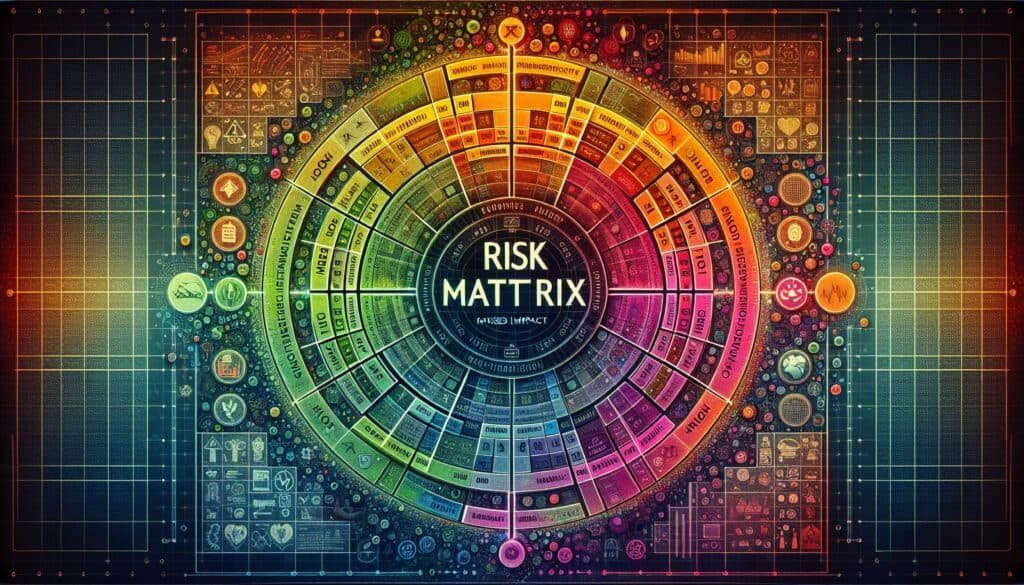A visual tool used to assess and prioritize risks based on their likelihood (or probability) of occurrence and the severity of their potential consequences.
- Methodologies: Engineering, Quality
Risk Matrix

Risk Matrix
- Continuous Improvement, Process Improvement, Project Management, Quality Assurance, Quality Control, Quality Management, Risk Analysis, Risk Management
Objective:
How it’s used:
- A grid where one axis represents the likelihood of a risk occurring (e.g., low, medium, high) and the other axis represents the severity of its impact (e.g., minor, moderate, major, catastrophic). Risks are plotted on the matrix, and different zones (e.g., green, yellow, red) indicate risk levels and priority for action.
Pros
- Simple and intuitive way to visualize and compare risks; Facilitates communication about risk levels and priorities; Helps in deciding which risks require urgent attention and mitigation efforts.
Cons
- Can be subjective, as likelihood and severity assessments often rely on expert judgment or qualitative scales; May oversimplify complex risks; Does not inherently suggest specific mitigation actions; Different stakeholders might assess risks differently.
Categories:
- Manufacturing, Product Design, Project Management, Quality, Risk Management
Best for:
- Quickly assessing and prioritizing multiple risks to determine which ones warrant immediate attention and resource allocation for mitigation.
The Risk Matrix methodology finds extensive application in various industries such as construction, healthcare, financial services, and product development, where identifying and managing potential hazards is imperative for project success. This tool is particularly useful during the risk assessment phase of projects, allowing teams to visualize risks based on their likelihood and impact, thereby informing strategic decisions related to resource allocation and risk mitigation strategies. Typical participants in this process include project managers, engineers, safety officers, and stakeholders who collectively assess and prioritize risks based on the plotted matrix. For instance, in software development, a Risk Matrix can help teams recognize potential vulnerabilities and their severity, guiding them in addressing those that threaten functionality and user experience. The simplicity of the grid mechanism facilitates effective communication among multidisciplinary teams, ensuring everyone shares a common understanding of risk levels, which enhances collaboration and informed decision-making. In highly regulated industries, this methodology supports compliance by clearly delineating areas that require immediate attention, thereby promoting a proactive rather than reactive approach to risk management.
Key steps of this methodology
- Identify potential risks relevant to the project.
- Assess the likelihood of each risk occurring using defined criteria.
- Evaluate the potential impact of each risk, categorizing them into severity levels.
- Plot each risk on the matrix according to its likelihood and impact.
- Analyze the plotted risks, identifying those in high-priority zones for action.
- Develop and implement mitigation strategies for prioritized risks.
- Monitor and review risks regularly, updating the matrix as necessary.
Pro Tips
- Regularly update the Risk Matrix based on new data and evolving project conditions to ensure accuracy and relevance.
- Incorporate stakeholder feedback in risk assessments to enhance the understanding of potential impacts and likelihoods.
- Use quantitative methods, such as fault tree analysis or failure mode effects analysis (FMEA), alongside the Risk Matrix for deeper risk insight.
To read and compare several methodologies, we recommend the
> Extensive Methodologies Repository <
together with the 400+ other methodologies.
Your comments on this methodology or additional info are welcome on the comment section below ↓ , so as any engineering-related ideas or links.
Historical Context
1960
1960
1969
1976-05-28
1980
1990
1960
1965
1970
1980
1980
(if date is unknown or not relevant, e.g. "fluid mechanics", a rounded estimation of its notable emergence is provided)











Related Posts
Master Production Schedule (MPS)
Mass Customization
Marketing Funnel
Marketing Audit
MAPO Index (Movement and Assistance of Hospital Patients)
Manufacturing Resource Planning (MRP II)